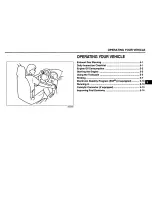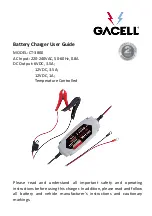
If the
å
ESP
®
OFF warning lamp lights up con‐
stantly in the instrument cluster, ESP
®
is deacti‐
vated.
Observe the information on warning lamps and
display messages which may appear in the instru‐
ment cluster.
Functions of ESP
®
Crosswind Assist
Crosswind Assist does not react under the follow‐
ing conditions:
R
The vehicle is subjected to severe jolts and
vibrations, e.g. as a result of uneven surfaces
or potholes.
R
The vehicle loses traction, e.g. on snow or ice
or when hydroplaning.
R
The driver is performing sudden and large
steering movements.
Crosswind Assist is operational again as soon as
the driving conditions return to normal.
Crosswind Assist detects strong crosswind gusts
that can impair ability of your vehicle to drive
straight ahead. Crosswind Assist intervenes
depending on the direction and strength of the
crosswind.
A stabilizing brake application helps you to keep
the vehicle on track.
Information is shown in the instrument cluster in
the event of a clearly discernible intervention by
Crosswind Assist.
Crosswind Assist is active above a vehicle speed
of 50 mph (80 km/h) when driving straight or
slightly cornering.
Function of ESP
®
trailer stabilization
&
WARNING Risk of accident in poor road
and weather conditions
In poor road and weather conditions, the
trailer stabilization cannot prevent lurching of
the vehicle/trailer combination. Trailers with
a high center of gravity may tip over before
ESP
®
detects this.
#
Always adapt your driving style to suit
the current road and weather condi‐
tions.
ESP
®
trailer stabilization counteracts critical driv‐
ing situations in good time and thereby provides
considerable assistance when driving with a
trailer. Trailer stabilization is part of ESP
®
.
If the sensor system and evaluation logic detect
trailer swinging movements, ESP
®
trailer stabili‐
zation initially brakes individual vehicle wheels in
a targeted manner. It thus counteracts swinging
movements. If the swinging movements do not
stop, the vehicle is braked until the vehicle/
trailer combination is stabilized. If necessary, the
vehicle's engine output is limited.
If your vehicle with trailer (vehicle/trailer combi‐
nation) starts to swerve, you are able to stabilize
the vehicle/trailer combination only by braking.
ESP
®
trailer stabilization helps you to stabilize
the vehicle/trailer combination in this situation.
ESP
®
trailer stabilization is active at speeds
above approximately 40 mph (65 km/h).
If ESP
®
is deactivated because of a malfunction,
trailer stabilization will not function.
Function of EBD (electronic brake force distri‐
bution)
EBD has the following characteristics:
R
monitoring and controlling the braking force
on the rear wheels
R
improving driving stabilization when braking,
especially on bends
Function of Active Brake Assist
Active Brake Assist consists of the following func‐
tions:
R
Distance warning function
R
Autonomous braking function
R
Situation-dependent braking assistance
Active Brake Assist can help you to minimize the
risk of a collision with vehicles or pedestrians or
to reduce the effects of such a collision.
If Active Brake Assist has detected a risk of colli‐
sion, you will be warned visually and acoustically.
If you do not react to the visual or acoustic warn‐
ing, autonomous braking can be initiated in criti‐
cal situations.
If there are pedestrians and cyclists crossing: in
especially critical situations, Active Brake Assist
can initiate autonomous braking directly. In this
case, the visual and acoustic warning occurs
simultaneously with the braking application.
Driving and parking 145
















































